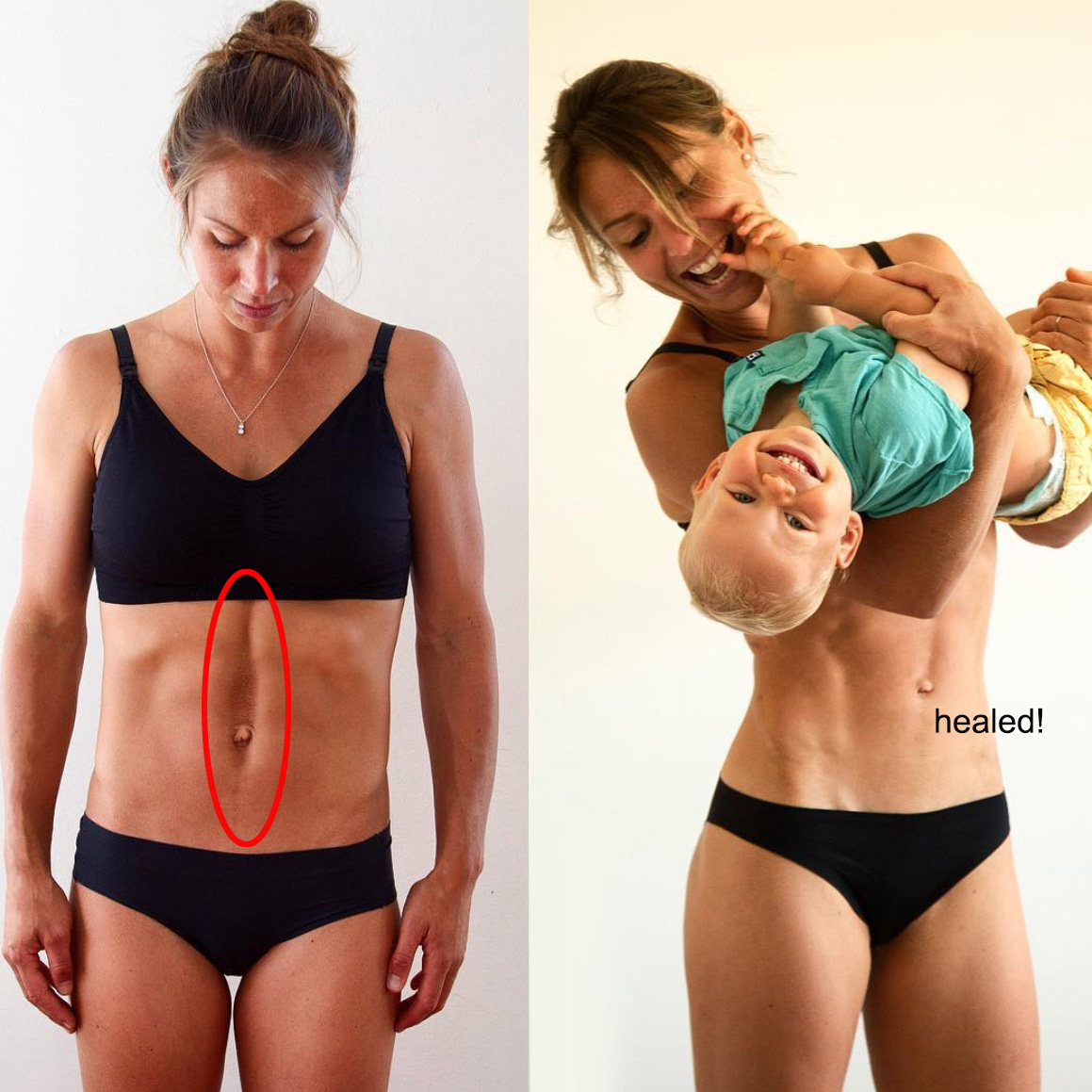Heal your Core with Diastasis Recti Exercises
Who knew that diastasis recti was a thing before entering the amazing journey of motherhood?!
Still under-diagnosed and under-treated, diastasis recti touches at least 60% of postpartum women.
You see, you’re far from being alone…
The good news is appropriate diastasis recti exercises can tighten the gap. It’s never too late to start doing the right exercises for diastasis recti to make improvements to strengthen, stabilize and make your tummy look better! Yes, you heard me, even if your youngest is in school or university you can start working on it now and see/feel great improvements.
Let’s start with a little clarification:
Different variations of diastasis recti
From a technical view, a Diastasis Recti (DR) is a thinning or stretching of the linea alba which is the fascia connecting the two rectus abdominal muscles (6-pack muscles). Medically defined as a 2 finger gap or greater, we also need to take the depth of the gap in consideration as this indicates the health of the connective tissue and core strength.
From a Mom’s perceptive, it’s usually described as “mommy-pooch” or “mummy tummy” with a wider waist. You know… this post-pregnancy belly that doesn’t go away when the baby weight does!
Let me explain “why” this post-pregnancy belly doesn’t go away with the baby weigh.
If you have a squishy 2 finger gap or more, then there’s a good chance that your connective tissue has lost integrity and may not carry tension well. In other words, your core is weakened, disconnected and its function is compromised, leaving the abdomen unsupported – so much that your stomach protrudes forming the pooch!
As if aesthetic consequences weren’t bad enough, the lack of stability and strength in the entire core and pelvic region leads to very unpleasant repercussions like peeing your pants while sneezing, coughing, jumping, running, or possibly even organ prolapse, abdominal hernia and back pain… These symptoms are usually associated with being a normal part of the “becoming a Mom” package. These discomforts, aches and pains are too often ignored, go untreated and get worse!
My own diastasis recti recovery journey with my 6 week Better Body after Baby program
The good news is it doesn’t have to be that way! You don’t have to be in pain, leaky or unsatisfied about your stomach since you became a Mom. Just because the conditions are “Common” doesn’t mean they are “Normal”. No matter how old your youngest is, diastasis recti repair exercises can always make improvements to your core strength, stability and function, also improving your flat stomach! We all deserve to live a pain-free motherhood and feel great about our bodies! This is why I created a 6-week comprehensive program called Better Body after Baby - giving access to diastasis recti repair exercises to thousands of women all over the world.
If you’ve been diagnosed with a diastasis recti, don’t worry, it doesn’t have to be the end of your fitness life and flat tummy! Now is the perfect time to approach fitness and body awareness with new eyes and new tools like ab exercises for diastasis recti and more.
Postnatal workout plan - The Better Body after Baby Program
Diastasis recti repair exercises
What should you consider?
“Strengthen your core”, they say… Easier said than done! Not all core exercise are diastasis exercise safe and will necessarily fix the problem. Some can even make things worse. Let’s dive into the subject:
First, you need to understand the “Excessive Intra-Abdominal Pressure” concept
(Rest assured, it’s much easier than it sounds!)
In short, this is the potentially harmful pressure inside your abdomen and pelvic cavity. Bad postures and crunches are the perfect examples to explain what happen inside your abdomen when the pressure is high. Start by picturing yourself doing a crunch, or simply stand or sit with slouched shoulders. As you may see (and feel), the distance between your shoulders and hips is shortened, increasing the “intra-abdominal pressure”.
When the pressure is high, it pushes:
behind your abdominal mid-line: you may see a bulge popping out on your ab mid-line,
downward: increasing the chances of pelvic floor dysfunctions such as prolapse and stress incontinence,
upward: compromising proper breathing because the diaphragm can not move optimally.
An efficient diastasis recti exercise program covers multiple aspects of your daily life, and if you understand this concept you’re on road to heal yourself!
(Click on each title bellow to reveal the drop-down content)
+ RE-STRENGTHEN
There’s no secret here. Re-strengthening rhymes with exercising! But there are harmful core exercises and diastasis recti repair exercises! Women are told that core work — for instance, front planks and tons of crunches — will tone the tummy and close the gap… unfortunately that’s just wrong! Sadly many core exercises can simply aggravate the situation!
To re-build strong foundations you need strategy and care. Ab exercises for diastasis recti focus on the deepest layer of your abs: the transverse muscles. Acting as a natural “corset” or “girdle”, they hold the internal organs in place. You can now imagine why strengthening them is so important to strengthen the transverse to flatten your low tummy! If they are weak: your organs fall forward against the ab-midline, giving you this pregnancy look!
The Transverse Abdominal muscles’ main job is to activate the core musculature and stabilize the pelvis and low back prior to movement of the body. Isn’t it what we want to achieve here? When performed properly, diastasis exercises using abdominal breathing techniques allow you to strengthen your deep core and pelvic floor without increasing the intra abdominal pressure. Abdominal breathing exercises combine transverse and pelvic floor exercises. Hello flat tummy and leak-free life! …But that’s not all, there’s more to consider, so let’s see a little further diastasis recti workout.
+ RE-ALIGN
If strengthening your core with ab exercises for diastasis recti is essential, it’s only one piece of the puzzle! Having the right abdominal separation exercises can make magic happen IF you also address the non-exercise aspect affecting your ab mid-line.
Indeed, even when perfectly performed, efficient and proven isolated diastasis recti exercises have a limited power action IF you don't adjust your alignment in your everyday activity: standing, picking up toys, carrying your baby, breastfeeding... Everyday life is very demanding on our core and good form shouldn’t only apply to workouts. I used to skip all the chapters of my pregnancy or postnatal books containing the word “posture” in them (Hello postpartum back pain!). I wanted “real exercises”... Oh, to have that time back! Posture is key ladies. Trust me, I wasn’t educated on the subject after my 1st baby and I made some damaging mistakes. So learn from my experience and mind your posture in your daily activities. Each time you slouch your shoulders, round your back, and forget your form, you are increasing the pressure behind your fragile ab mid-line and pelvic floor, damaging those fragile areas and preventing their recovery! So let’s address the pressure causing the problem by working on your daily posture and you’ll be a long way into your healing journey!
+ RE-CONNECT
Reestablishing the connection between the muscles and the brain with specific diastasis recti exercises is essential. This re-connection goes further than the ab muscles and we need to take into consideration the whole system and understand what happened during pregnancy.
During pregnancy, transverse and pelvic floor muscles can basically turn off, especially when pregnant women ignore their core altogether. The diaphragm and breathing patterns are also completely disrupted! The reasons are simple – the growing baby takes so much space into our abdomen that : the diaphragm can’t expand as much as it could before the pelvic floor and ab mid-line are subject to a lot of pressure
Even after delivery, many postpartum mamas continue to breathe improperly… It requires active work to reconnect brain to muscle and make everything work correctly again! A comprehensive diastasis recti exercise program needs to take all these parameters into consideration.
You may start to feel that there’s a lot to fix to get rid of this mummy tummy! Honestly, it does sound more complex than it actually is! Believe me… I was a mess too – I suffered from a very deep gap with embarrassing pelvic floor dysfunction. Every diastasis recti exercise at the beginning of the journey was definitely harder on my brain than on my abs, but once I had the right tools, exercises and mindset I improved quickly, impacting all the aspects of my life and the relationship with my own body!
RE-STRENGTHEN - RE-ALIGN - RE-CONNECT
What else?
Core - Posture - Breathing
The core and the breath are designed to work together and can only work well if posture is optimal. This is essential to understand when trying to heal a diastasis recti and any associated issues.
Once the breath is functioning properly, so many other things start falling into place! That’s why efficient diastasis recti workouts are based on an abdominal breathing technique.
RE-TUNE
Have you noticed that instead of being kind and loving with their body a lot of Moms look in the mirror with their most critical set of glasses?! If you are one of those, try to talk to yourself as if you were talking to your best-friend and supporting her. We often make the most negative and degrading judgements about ourselves! Your body has done something truly amazing by growing and birthing a baby!
Fixing your core with a positive mindset will definitely make this challenging temporary stage of your life easier.
Remember that there will never be a “perfect time” to start a diastasis recti exercise program and start your recovery journey. It’s easy to procrastinate and put yourself last (we, Moms, know how to do that too well…)!
Make yourself a priority and invest in your body and long-term health.
Love yourself and dare re-tuning into your body to heal your core and pelvic floor. Remember, a healthy happy Mom means a healthy happy family.
A diastasis recti affects every dimension of a woman’s life
Body image,
Self-confidence,
Fitness life,
Sexual life,...







